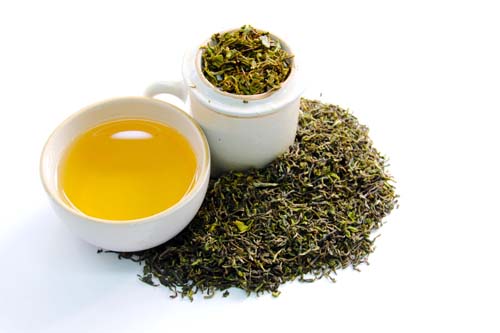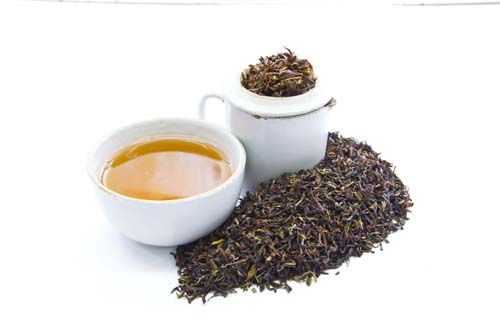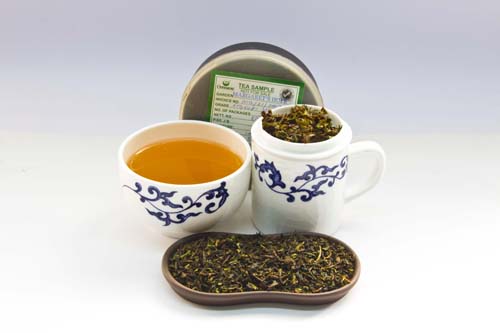Some people say there are three flushes each growing season in Darjeeling and others say there are four flushes, maybe even five. But what is a flush? And how does the tea from each one vary?
WHAT IS A FLUSH
Some people assume that “flush” only refers to the actual act of harvesting. However, a flush is a period where the tea plants grow new leaves that are then harvested either by machine or by hand, often determined by the type of tea being produced. Just as with most plants, the tea plant (Camellia Sinensis) goes through periods of growth and then dormancy, varying with the location where they are grown. (Some locations, such as Nilgiri, harvest year round but still on a schedule of flushes, that is, letting the plants grow a covering of new leaves, harvesting them, and then another covering grows.) When the plants “awake” from their dormant state in early Spring, the first growing season starts, leading to the first harvest and thus completing the “flush.”
While the exact names of flushes vary from region to region, the terms “First Flush” and “Second Flush” are common, especially for Darjeeling teas where the better quality ones often include their flush in the tea name. For example: Jungpana FTGFOP 1 CL 2nd Flush 2013 (a tea I got to sample) is from the Jungpana tea garden and was harvested at the end of the second growth period during the growing season in the year 2013. Simple!

This is the first growth after dormancy. The plucking/harvesting time varies by location, some being between late February to mid April, others not starting until early March and going thru mid April. Some call this the “Spring Flush” or “Easter Flush.” If the weather is right, this could be the best flush of the growing season and command high prices from tea connoisseurs.
Often the leaves are plucked while they are still tender new shoots on the stalks of the tea bushes. They are called “buds” but are not like flower buds. They are instead the much sought “two leaves and a bud combo” used in “tippy” teas. They are supposed to contain the most catechins (antioxidants), L-theanine (a stimulant), and caffeine of any of the pickings, but there is some on-going discussion about this, especially the caffeine part. Their shelf-life is usually rather short (a few months at most).
The steeped liquid is described in various ways: very delicate tasting, light infusion with a pale color; a generally intense muscatel with ‘point’; a light yellow to coppery red cup color with delicate flowery aroma; a delicate, floral, pale infusion, usually made into black tea, but sometimes white; a tea that is peachy and greenish; a greener muscatel flavor of tea; outstanding flowery meadow-like flavor, and so on.
Darjeeling is the “Land of the Thunderbolt” and sits at the feet of the Himalayas. The storms that roll across the region play an integral part in the growing cycle of the tea plant, which is an evergreen and tropical, needing lots of rain to grow. Just after the first flush, storms come through and the plants, having soaked up all that moisture, go dormant briefly, and then comes the next period of growth (the second flush). [Note: Not all areas of Darjeeling produce subsequent harvestable growths.]
IN-BETWEENERS (late April to early May)
Some plantations trim new growth that sprouts after the first flush is harvested to encourage a growth spurt in the tea plants that they can harvest for making very low-grade tea. They do not mark this tea with a flush and typically use it for bags and/or local markets. Harvesting these Darjeeling “In-Betweeners” begins in late April to early May, and the leaves steep up an astringent but rounded cup of tea, a step away from Second Flush Darjeeling teas.
 SECOND FLUSH (late May to June)
SECOND FLUSH (late May to June)
Whether or not an “in-between” harvest is made, this official Second Flush is the growth that follows a brief period of dormancy. These tea leaves are picked from late May to June and produce an amazing, well rounded, mature and fruity flavor of tea that is said to be less astringent and even better than the first flush. The leaves steep up a liquid that is bright with a taste that is full, round, and has an excellent muscatel character – perfect for your afternoon tea time with scones and raspberry conserve. Some claim this flush steeps up a tea with a marvelous muscatel character. Some say it is the lowest quality flush whereas others drink nothing else.
Having tried a number of Second Flush Darjeelings, I rounded up a few of the impressions hubby and I had had:
– … a general planty sweetness.
– … a mild, delicious green tea…Very distinctive taste…clearly a tea from Darjeeling, India.
– Very different from the other Darjeelings yet having a distinctive Darjeeling taste.
– Another distinct tasting tea that still has the overall characteristics of a tea from Darjeeling, India.
– Complex flavors seemed to change with each sip as the tea cooled. That world-renowned muscatel-like flavor was evident, especially in the aftertaste.
– …started out woodsy when hot and turned fruity and smoother as they cooled.
– …the flavor…changed subtly as it started to cool after being poured into the cup. …The fruitiness became more pronounced with a planty finish…
– …the flavors…changed, with the characteristic Muscatel flavor becoming more pronounced with a nutty hit to the roof of my mouth. …this tea needs no sweetener or milk. Just a fabulous and refreshing white tea!
A fine Summer Flush tea from a reputable garden can be just as distinctive and flavorful as a First Flush.
MONSOON FLUSH - September
As previously stated, the tea plant is one that needs a lot of moisture. It tends to thrive in areas subject to monsoonal weather patterns. In Darjeeling heavy rains fall from July until September. The Second Flush has to be harvested before these rains start. After the rains stop, the tea plants start growing again, producing harvestable leaves that some gardens process as green teas to meet the growing demand. Others use the leaves in teabags and blends due to their stronger flavor. The leaves are plentiful but considered lower quality, steeping a dark tea liquid with a dull flavor.
 THIRD (AUTUMN) FLUSH – harvested October and November
THIRD (AUTUMN) FLUSH – harvested October and November
Finally, there are the Darjeeling Third Flush teas, more commonly called “Autumn Flush” or even “Autumnals,” known for their large leaves. Careful tending of the garden after the Second Flush is a must, whether or not a Monsoon Flush harvest is attempted, to prepare for this flush. Weeding is essential as is a good fertilizing since the tea plants will do most of their growth during Autumn. They aren’t always available (weather conditions have to be just right). In mid-September the monsoon season ends and the tea plants resume growth until October and November when they are harvested. The leaves produce a very dark leaf that steeps up a full-bodied and naturally fruity flavored tea (the buds contain more sap than normal due to slower growth). The ones that do make it to market typically have a coppery colored liquid and a nice round taste, quite suitable as a breakfast tea and stronger than the Second Flush. Hubby and I even find that they can take a very small amount of milk and a little sweetener, if you so desire.
WINTER FLUSH - harvested between November and February
Around October, the tea plants are pruned to prepare them for Winter, and tea plants under four years of age must be protected from the cold. However, sometimes another flush is possible. The fairly rare Winter Flush is usually harvested between November and February, but only under the best weather conditions and even then the quality is rather low. The tea plants are most often dormant from December to February.
ABOUT THE AUTHOR: A.C. Cargill writes about tea, edits two tea company blogs, and is the human caretaker of Little Yellow Teapot (who has his own blog and steeps up the samples of our teas we send them both). She hasn’t been asked to speak at any tea conference yet, but we’re sure that’s just a soon-to-be-corrected oversight.
